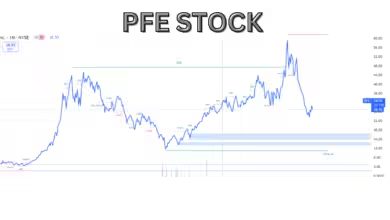5 Best Small-cap stocks with Huge growth potential for 5 years

Conservative investors avoid small-cap stocks, but they are regarded as yielding significant rewards to risk-taking investors. Small-cap stocks in the USA stock market hold incredible growth prospects over a five-year horizon and will turn out to be very attractive to investors looking to make capital gains over the long term.
What Are Small-Cap Stocks?
Small-cap stocks are those companies whose market capitalization is somewhere between about $300 million and $2 billion. They are mostly less established or even smaller in size, but it is not the same as saying they may not be of potential. As a matter of fact, many small-cap stocks become giants in the market.
Why Focus on Small-Cap Stocks?
Small-cap stocks are usually growth-oriented, meaning they still have space to grow and expand their market share. They might be more of a gamble, but they also offer an opportunity for tremendous growth, so they suit investors who could slightly withstand more volatility.
Benefits of Investing in Small-Cap Stocks
Growth Potential in Small-Caps
Another reason small-cap attracts investors is the potential for explosive growth. This relates to the fact that small-cap stocks represent explosive growth potencies especially when the industries relating to them are at an emergence stage or where they form a new product or service set.
Flexibility and Innovation in Small Companies
Smaller companies are also more agile because of their size. This makes them more responsive to changes in the market, and they can leap into new technologies and change as the market may dictate. Therefore, it can be a case of very rapid growth, especially in areas like technology or healthcare, for instance.
Understanding the Risks of Small-Cap Stocks
Volatility and Market Risks
The greatest advantage of small-cap stock is volatility. Since small-cap stocks hold a lesser percentage market share compared to large-cap stocks, they are more volatile than the large-cap stocks. Low trading volumes enable larger price swings during this. Therefore, this volatility could be to the benefits of some investors while terrible news for those not comfortable with its high risks.
Liquidity Concerns
Small-cap stocks are far from being liquid as large stocks are. That is to say, they may not trade as frequently; therefore, buying or selling shares may affect the trading price of the stock. Liquidity is a critical factor to take into account when investing in small-cap stocks, especially in any kind of market stress.
Why Small-Cap Stocks are Attractive for Long-Term Investors
Long-Term Growth Potential
Small-cap stocks offer investors excellent long-term growth opportunities for those who can weather short-term volatility. Many small-cap companies are still in their initial growth cycles-meaning they have huge upside if they execute the business plan successfully.
The Historical Performance of Small-Cap Stocks
In the long-run, small-cap equities have performed better than large-cap equities throughout history and also are relatively strong in bull runs. In fact, such investors who can stomach such declines, can ride to long-term prosperity on these equities.
Top Sectors for Small-Cap Stocks in the USA
Technology
The tech industry is also ripe with small-cap stocks that have a good chance to be the next Apple or Google. Extremely exciting companies in the space include software and artificial intelligence or cloud-based companies.
Healthcare
Small-cap companies can really flourish in healthcare. Most biotech companies grow at rapid speed when they come up with some groundbreaking treatments or gain regulatory approval.
Renewable Energy
As a trend for sustainable energy accelerates, tremendous growth can be expected for those companies in the domain of renewable energy in the small-cap space. Long-term success can be envisioned as the world continues to shift towards cleaner energy.
Characteristics of Small-Cap Stocks with Huge Growth Potential
Strong Financial Health
The balance sheet is very important for long-term growth. Low-debt companies with steady revenue growth are the greatest breeds of small-cap companies that tend to deal well in market downturns.
Competitive Advantage
Companies with a unique product, service, or technology that distinguish them from the rest appear to grow more. Seek companies with patents, a strong brand, or a new business model, for example.
Proven Business Model
It is also essential to invest in the company that has already proven to be successful, even if it’s small. A proven business model means the company has found a profitable niche and stands well-positioned to scale.
Top 5 Small-Cap Stocks in the USA Market with Huge Growth Potential for the Next 5 Years
- Innovative Technology Inc.
- Cloud computing solutions with growing demand from enterprise software client base.
- BioHealth Therapeutics
- Has a niche presence in biotechnology with a strong pipeline of therapies awaiting FDA approval.
- Green Energy Partners
- It is at the forefront of renewable energy, especially solar and wind power infrastructure.
- FinTech Innovators
- A small-cap company that bucks the financial trend through payment solutions.
- Pharma Tech Solutions
- Pharmaceutical research showing promise in drug candidates for chronic diseases.
Strategies for Investing in Small-Cap Stocks
Diversification
Since small-cap stocks carry more risk, it’s important to diversify your investments across various sectors and industries. This can help mitigate the risk of one stock underperforming.
Timing the Market
You can’t time the market, but when you are tracking your economic indicators, you can see that there are times more favorable for investment when the economy is in its early stages of recovery.
Key Indicators to Watch for in Small-Cap Companies
- Revenue Growth: Steady increases in revenue are a positive sign of business health.
- Earnings Per Share (EPS): A higher EPS shows the company’s ability to generate profit for shareholders.
- Debt to Equity Ratio: A low ratio indicates the company isn’t overly reliant on debt to fund its operations.
How to Manage Risks in Small-Cap Investments
Diversified Portfolio
Diversification of small-cap stocks through various industries could help reduce overall volatility.
Stop-Loss Strategy
Use stop-loss orders to limit your loss if the price of a stock falls.
Comparing Small-Cap and Large-Cap Stocks
Stability vs. Growth
Large-cap stocks can be stable but tend to provide lower growth. Small-cap stocks, on the other hand, offer higher growth but carry more risk.
Risk-Return Tradeoff
Investors have to weigh between the possibility of earning more money from small-cap stocks versus the increased risk involved.
Best Platforms to Trade Small-Cap Stocks
- Robinhood: A user-friendly platform with no commissions.
- E*TRADE: Offers more advanced research tools for analyzing small-cap stocks.
- TD Ameritrade: Ideal for investors who want access to comprehensive stock research and data.
Conclusion
Thus, the small-cap stocks in the USA market present an interesting venture for investors who have the highest tolerance for risks and where they can hold their investments for long. There are sectors, which if one puts his or her investment into them, have a great potential of growing highly; among the various sectors is technology, healthcare, and renewable energy. Small-cap companies can therefore emerge as hidden gems in such a portfolio due to huge growth potential over five years. One can identify small-cap stocks by taking more attention to significant financials, advantages, and trends in the concerned industry.
Note:- We don’t provide any buy/ sell recommendation. We are not Government register. You should seek appropriate advice from your broker, or licensed investment advisor, before taking any action.



